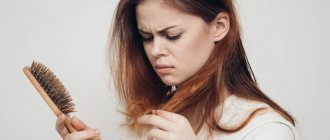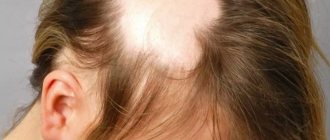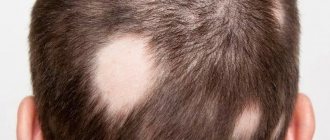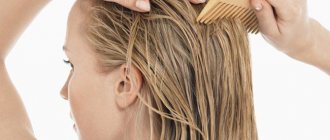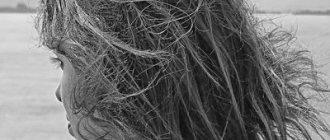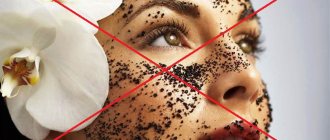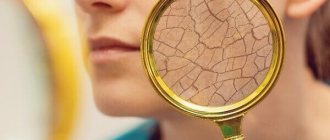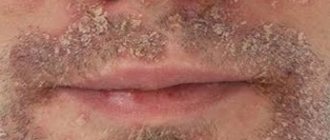From this article you will learn:
- Description of androgenetic alopecia
- The effect of androgens on hair condition
- Risk factors for developing androgenetic alopecia
- Symptoms of androgenetic alopecia
- 2 types of androgenetic alopecia
- Diagnosis of androgenetic alopecia
- 3 Ways to Treat Androgenetic Alopecia
- Drug therapy for androgenetic alopecia
- Treatment of androgenetic alopecia in men and women
- Laser therapy
- Mesotherapy and hair transplantation
- Treatment of androgenetic alopecia with traditional methods
Androgenetic alopecia is a special type of baldness that affects both men and women. This disease occurs due to hormonal imbalances that provoke intense hair loss in certain areas of the head. In the stronger half of humanity, such thinning of hair appears after 30 years, and in women after 50.
Various methods are used to treat alopecia, including medications, physical therapy, and surgery. The method of therapy is selected by the doctor depending on the causes of the disease.
Description of androgenetic alopecia
Alopecia is baldness. Androgenetic alopecia is a disease caused by increased sensitivity of hair follicles to dihydrotestosterone, the active form of the male sex hormone testosterone.
This hypersensitivity of the follicle to testosterone is a genetic disorder, which in 75% of cases is transmitted to the child from the mother. Medicine believes that androgenetic alopecia is a hormonal disease that can be hereditary.
Recommended articles on the topic:
- Diffuse alopecia in women
- Plasma therapy for the scalp
- Useful vitamins for hair: against hair loss and for growth
Androgenic (androgenetic) alopecia in men begins to develop in the frontal and parietal regions. Women first lose hair in the area of the central parting, then the hair thins on the top of the head. At the very beginning, the disease manifests itself in thinning hair and deterioration in its appearance. They become dull, lifeless and then fall out. Androgenetic alopecia is difficult to diagnose at first because it develops very slowly. The first signs of pathology appear only at the age of 30, and baldness becomes noticeable only after 10–15 years.
Many people note that with complete baldness of the frontal and parietal parts of the head, the back of the head remains covered with thick hair. This is a characteristic sign of androgenetic alopecia and is due to the fact that the follicles in this area are not sensitive to changes in the level of dihydrotestosterone in the human body.
Course of the disease
This type of alopecia is a disease in which the loss of hair spreads from the center of the head (parting) to the sides. The severity is assessed according to the table. Trichologists call it the “Ludwig scale”. Genetics has a great influence on the form of the disease. There is an opinion that protein formation occurs through stimulation of the immune system. The impetus for this is the activation of certain genes, as a result of which the hair follicle suffers and loss of the shaft occurs. Factors contributing to “gene activation” are problems of various etiologies - stress, vaccinations, taking antibiotics, other drugs, etc.
The effect of androgens on hair condition
Male sex hormones are collectively called androgens. They are produced in all people, but their quantity is related to gender; women have significantly less such hormones.
One of the androgens is testosterone, due to its high level in men:
- large and strong muscles;
- hair grows in large quantities not only on the head, but also on the face and body;
- mammary glands do not develop;
- a characteristic male voice, low and rough, and good stamina.
Androgens are necessary for the metabolic process and are responsible for normal sugar levels. The strength of their effect on the body differs, so androgens are divided into two groups - weak and strong. Testosterone, already familiar to us, and its weaker version, dihydrotestosterone (DHT), belong to the strong group. They are part of the enzyme 5-alpha reductase, which, with a genetic predisposition, can be present in the scalp and can cause the development of androgenic alopecia.
Despite the fact that androgens and estrogens have common metabolic processes, their effects on the body are opposite. The lifespan of hair depends on estrogen levels. One of them, estradiol, is especially actively produced during pregnancy. This is why women in interesting situations have hair that becomes thicker and practically stops falling out.
In the first weeks after childbirth, estrogen production decreases sharply, and hairs in the growth phase begin to fall out, and the hair noticeably thins.
Risk factors for developing androgenetic alopecia
When studying the causes of androgenetic alopecia, experts identified several factors leading to the development of pathology:
- Gender. Men suffer from androgenic pattern baldness 4–5 times more often than women.
- Age. Every second man and fourth woman over 50 years old finds signs of androgenetic alopecia.
- Hormonal imbalance. Hormonal imbalance in women usually occurs after pregnancy or during treatment with medications containing male hormones. In men, the cause of alopecia can be the use of drugs that activate testosterone production, for example, various types of doping agents.
- Heredity. If androgenetic alopecia was identified in previous generations, or if relatives suffered from severe hair loss for no apparent reason, then the probability of this pathology occurring in subsequent generations is close to 80%.
- Various types of tumors and damage to the glands that produce sex hormones.
- Hyper- or hypofunction of the pituitary gland.
- Oncological formations in the adrenal glands or increased function due to certain diseases.
- Decrease or increase in the level of hormones produced by the ovaries and testicles in orchitis, polycystic disease, ovarian sclerocystosis, ovarian disease.
If the patient has at least one of the listed risk factors and his hair has noticeably thinned, then you should not postpone a visit to the dermatologist. After examination, the doctor will either decide that it is androgenetic alopecia or diagnose another cause of hair loss.
Cosmetic aids
Since so much of the morbidity of FPHL lies in body image disturbances, cosmetic aids are an integral part of management options. These incorporate hair styling techniques, camouflage products, hair replacements, hair accessories, and additions.
FPHL is an under-recognized entity. Significant hair loss is seen in over ¼ of females over the age of 50. Satisfactory management of this condition requires a knowledge of possible underlying causes, physical comorbidities, possible differential diagnoses, and the various therapeutic modalities available. It also requires an appreciation of the potential psychological effect of hair loss on affected individuals, and sensitivity during patient consultations.
The condition is progressive without treatment. Current pharmacological treatment stems further progression and can also stimulate partial regrowth.
Regardless of which medication is utilized, the response is slow, and requires patience and persistence in both patient and clinician. The cosmetic effects of this condition should not be underestimated, thus cosmetic aids and surgical options are both important adjunctive options that need to be discussed with these patients in addition to pharmacotherapy.
Symptoms of androgenetic alopecia
Determining that hair loss is the result of androgenetic alopecia is not so easy. Symptoms may be mild; the correct diagnosis will depend on the gender of the patient and examination of the hair for pathological changes. The only characteristic sign is damage to the hair follicles only in the forehead and crown of the head, because it is in these parts of the hairline that an enzyme sensitive to dihydrotestosterone is found.
The manifestation of androgenetic alopecia in women may look like:
- decrease in hair density in the frontal and parietal parts of the head, but it does not reach complete baldness;
- changes in the menstrual cycle - androgens interfere with the work of estrogens, which causes menstrual irregularities;
- acne, usually appearing on the face and back;
- hirsutism – hair growth in places where women traditionally do not have pronounced hair (chest, back, face).
Androgenetic alopecia in men makes itself felt by sparse vegetation in only two areas of the head - frontal and parietal.
Forecast
Progress with this disease is very positive. You should expect a good result with the right approach and choice of therapy. In the case of endocrinological disorders, it is necessary to establish the correct production of hormones - this is done by increasing or decreasing the level of others in the body. But even if treatment for androgenic hair loss in women is not productive, then, as mentioned earlier, a bulb transplant is possible. Transplantation is very effective - the procedure is successful in 85%.
There are two varieties of this method. The first involves using and transplanting a piece of skin taken from another area of the body, often the back of the head. Another way is seamless. In this case, the bulbs are removed one at a time using a special tool. Then they are washed, processed and implanted in the required place. It is typical that in this case the strands change properties. They become longer, smoother and rebuild their structure.
Diagnosis of androgenetic alopecia
Sometimes androgenetic alopecia is determined based on a visual examination, since in patients with this pathology the level of hormones in the blood does not exceed normal. To exclude other possible causes of severe hair loss and determine effective treatment, diagnostic and laboratory tests are prescribed.
Types of tests for androgenetic alopecia in women and men:
- biochemical blood test - to determine the amount of microelements;
- tests for TSH, T3, T4 - for the presence of thyroid hormones;
- tests for sex hormones - to determine the level of testosterone, prolactin, estrogen;
- complete blood count and serum iron test;
- analysis for the level of adrenocorticotropic hormone (if adrenal disease is suspected).
If this is necessary, then to complete the picture, the attending physician may prescribe an ultrasound of the adrenal glands and a CT scan of the brain. The patient is referred for consultation to an endocrinologist, gastroenterologist, gynecologist, neurologist, and trichoscopy is performed.
Benefits of therapy at An-Tech Labs
- Experienced doctors. Our trichologists have been specializing in hair treatment and restoration for many years. They have everything necessary for effective therapy.
- A comprehensive and individual approach to treatment. Thanks to it, the condition of the hair improves very soon after the start of therapy. At the same time, the treatment process is safe, as it is carried out taking into account the patient’s concomitant pathologies.
- Optimal cost of hair therapy. We adhere to a loyal approach to treatment and do not inflate prices.
Contact us!
We will find an individual approach to treatment and prevent hair loss! You don't have to part with your gorgeous curls! Back to list of services
Mesotherapy and hair transplantation
Mesotherapy is the introduction of medications directly under the skin, as close as possible to the hair follicles. For therapeutic injections, combinations of vitamins and microelements are used. This method speeds up metabolism and fills the follicles with nutrients. Hair plasma lifting works in a similar way, when instead of drugs, blood plasma taken from the patient’s vein is injected under the skin.
Painful sensations during subcutaneous injections are minimal. In terms of time, one session is about 40 minutes; to obtain a visible effect, it is necessary to carry out at least 10 procedures. For androgenetic alopecia, the drug “Dutasteride” is used for medicinal mixtures as the most effective. Almost two thirds of patients who have undergone 12 sessions of this mesotherapy note a noticeable improvement in the condition of the scalp. In the photo, androgenetic alopecia becomes almost invisible.
For those who do not like injections, mesotherapy can be performed using a mesoscooter. There will be results too, but not quickly.
Not long ago, another method of treating androgenetic alopecia appeared - hair transplantation. In the first operations, artificial or foreign hair was used as transplant material. But in the postoperative period, many complications arose in the form of purulent inflammation and rough scars. Now the patient's own hair is used for transplantation. 1-2 follicles along with pieces of skin (grafts) are taken from the occipital or behind-the-ear area.
Causes of androgenic alopecia
Androgenic alopecia is a consequence of a hormonal disorder in which the amount of androgens in the body increases. The following negative exogenous and endogenous factors can trigger the mechanism of baldness:
- Hereditary predisposition. The tendency to androgenic alopecia is transmitted at the genetic level, both on the maternal and paternal lines.
- Hormonal changes. During puberty, pregnancy, and breastfeeding, the synthesis of androgens increases, but as soon as the hormonal levels stabilize, the problem of hair loss will resolve itself.
- Endocrine disruptions. Diabetes mellitus, benign or malignant tumors localized in the adrenal glands, polycystic ovary syndrome, pituitary hyperplasia, thyroid disease negatively affect the condition of the hair follicles, disrupting their nutrition and oxygen supply, leading to destruction.
- Taking certain groups of medications. Contraceptives, glucocorticosteroids, antidepressants, potent antibiotics, diuretics, anticoagulants, anticonvulsants, if used uncontrolled, can cause damage and death of hair follicles.
- Autoimmune diseases. Autoimmune diseases often cause alopecia areata. The most common include systemic lupus erythematosus, rheumatoid arthritis, scleroderma, and trieoiditis.
- Abuse of bad habits. Alcoholic drinks and cigarette smoke poison the body, disrupt the process of assimilation of nutrients, weaken the immune system, lead to disruption of the functioning of organs and systems, weaken hair, which stops growing and begins to rapidly thin out.
- Strict diets, unbalanced nutrition. With a poor diet, the human body does not receive enough necessary nutrients, vitamins, micro- and macroelements. This leads to weakened immunity and hormonal dysfunction, which negatively affects the condition of the hair.
- Stress. Chronic stressful situations negatively affect the functioning of organs and systems, leading to serious illnesses and hair loss. After such emotional overload, the curls thin out, become dull, and stop growing in length.
- Unbalanced diet. Deficiency of vitamins, nutrients, micro- and macroelements contribute to a decrease in the body's defenses and weakening of hair follicles, which become thinner and die over time.
Treatment of androgenetic alopecia with traditional methods
Since ancient times, traditional medicine has offered various ways to strengthen hair, increase the density of curls, and reduce the rate of baldness. But all of them will give the expected effect only when used together with medications.
- Onion rub. At the first signs of thinning, it is recommended to rub a mixture of chopped onion into the hair roots. Leave the mask on for an hour and a half, then wash off with strengthening or regular shampoo. If you add crushed garlic and a little honey to the onion mass, the procedure will be even more effective.
- Pepper tincture. Grind the pepper, pour in 100 ml of vodka and leave for 24 hours. Then rub the tincture into the scalp and after an hour and a half, wash your hair thoroughly.
- Onion-cognac tincture. Grind a medium onion through a meat grinder and pour 200 ml of cognac into it. The mixture should sit for several hours. To achieve a positive result, the tincture must be rubbed into balding areas of the head daily.
- Mustard mask with castor oil. Take one tablespoon of dry mustard, mix it thoroughly with 30 ml of castor oil and let it brew for 20-30 minutes. To reduce the amount of hair falling out, a mustard mask should be applied to the scalp for 40–50 minutes. The session is carried out before each hair wash 1-2 times a week.
- Nettle lotion. The therapeutic effect is obtained by using nettle for androgenetic alopecia. In a saucepan with 5 tbsp. spoon leaves, pour 450 ml of water, add 2 tbsp. spoons of vinegar and put on the stove. Bring the mixture to a boil, keep on low heat for half an hour, then remove and cool. The product should be rubbed into the scalp every day before bed.
- Salt mask. Good results are obtained by rubbing regular or sea salt into the scalp 30–40 minutes before washing it.
- Mask with vitamins and Dimexide. Mix 2 tbsp. spoons of castor and burdock oil, add to them 1 teaspoon of vitamins A, E and 1 tbsp. spoon of Dimexide. The prepared mixture is rubbed into the roots of thinning hair and left for one hour.
- Tincture to strengthen follicles. Pour 1 tbsp into a jar. spoon of nettle and crushed burdock root, pour a glass of alcohol, add 1 bottle of alcohol tincture of mint and propolis. Close the jar tightly and put it in a cool place for a week. Then filter the composition and pour into a container with an airtight lid. Rub the resulting lotion daily before bed.
- Mask with sea buckthorn oil. Mix 1 teaspoon of sea buckthorn oil with 6–8 drops of grapefruit oil, 1 teaspoon of vitamins A, E and heat in a water bath. Then add 1 spoon of Dimexide to the mixture. Apply the mixture to the hair roots and leave for an hour.
Due to the fact that androgenetic alopecia is difficult to treat, some medications will have to be used throughout life, taking short breaks between courses. Otherwise, baldness will progress.
Why clients choose Veronika Herba Beauty and Health Center:
- This is a beauty center where you can take care of yourself at a reasonable cost, while your face and/or body will be treated not by an ordinary specialist, but by one of the best in Moscow. This is a completely different, higher level of service!
- You can receive qualified help at any time convenient for you. The beauty center is open from 9:00 to 21:00, seven days a week. The main thing is to agree with your doctor in advance on the date and time of your appointment.
Sign up for a consultation with a specialist by phone +7 (495) 085-15-13
, and you will see for yourself!
Treatment options
Pharmacological
Pharmacological options can be divided into drugs with androgen-independent and androgen-dependent mechanisms of action.
Androgen-independent medications
Minoxidil Currently the only androgen-independent medication in widespread use is minoxidil topical solution. This medication's proposed mechanism of action is by affecting hair cycling, causing premature termination of telogen, and probably prolonging anagen. Understanding exactly how minoxidil exerts these effects is currently the subject of intense research. Although this is available in both 2% and 5% preparations, only the 2% solution is currently FDA-approved for FPHL (DeVillez et al 1994). A study comparing the efficacy of the two concentrations using target area hair counts at 48 weeks as a primary endpoint showed a mild nonsignificant advantage for the 5% solution (Olsen et al 2002).
Androgen-dependent medications
The use of all androgen-dependent medications to treat FPHL carries a risk of causing abnormalities in the genitalia of the male fetus. , these medications are contraindicated in women who are pregnant, which leads many physicians to recommend that women start and thus remain on an oral contraceptive pill throughout their course of treatment with these medications. As with minoxidil, all androgen-dependent medications need to be continued for at least 1 year before an accurate appraisal of efficacy can be made.
Finasteride Finasteride works by inhibiting 5α-reductase II enzyme, which is responsible for catalyzing the conversion of testosterone to the much more active chemical 5 DHT. Thus, finasteride suppresses overall androgen activity by restricting total circulating androgen activity.
Cyproterone acetate This medication inhibits gonadotropin-releasing hormone (GnRH) and blocks androgen receptors. Other uses include prostate cancer, hirsutism, and severe acne. Is commonly used combined with estradiol as an oral contraceptive pill named Diane-35.
Spironolactone Spironolactone is used widely to treat FPHL and hirsutism. It acts as an androgen antagonist by competitively blocking androgen receptors, as well as inhibiting ovarian androgen production. In the USA it is the most widely used antiandrogen to treat FPHL.
The side effect profile of spironolactone is perhaps more varied compared with other medications, due partly to its additional actions as an aldosterone antagonist. These include postural hypotension, electrolyte disturbances, menstrual irregularities, fatigue, urticaria, breast tenderness, and hematological disturbances.
Flutamide Flutamide is a potent antiandrogen, acting via androgen receptor antagonism. As such, it is commonly used to treat advanced prostate cancer and hirsutism. Being one of the newer antiandrogens, there is limited medical literature on its use in FPHL. Adverse effects due to flutamide are potentially severe. These include hepatic dysfunction and breast tenderness, both of which are dose-related.
